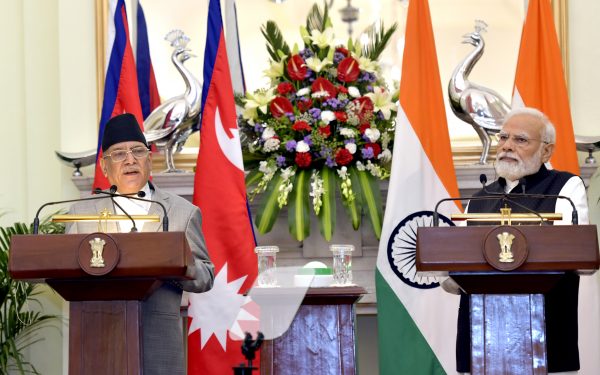The visit came at a time when India’s ties with Nepal have reached the lowest point in recent history. This is due to the ongoing border dispute and Nepal’s reservation about continuing the recruitment of Nepali Gorkhas in the Indian Army for a fixed four-year term under the controversial Agnipath Scheme.
The most recent contentions between India and Nepal began with the Indian government’s release of a new political map in November 2019. The need for a new map arose after the abrogation of Article 370 in the Indian Constitution, which ended the special status given to the state of Jammu and Kashmir and created a new Union Territory of Ladakh.
Nepal objected to the new map, alleging that its western boundary with India in the Kalapani region was incorrectly drawn. This caused a public uproar, with mass anti-India protests carried out across Nepal. Though India initially refuted Nepal’s allegations and continues to do so, New Delhi agreed to address Nepal’s concerns through diplomatic dialogue to calm the anti-India backlash.
But the then-ruling Communist Party of Nepal (Unified Marxist-Leninist) (CPN-UML) drew on this controversy to strengthen its political base. CPN-UML released a new map showing large Indian territories as Nepali. This new Nepali map received parliamentary approval, making the issue complicated for the diplomatic community to resolve.
The second issue clouding India–Nepal relations concerns the recruitment of Nepali Gorkhas in the Indian Army. This unique practice continued for seven decades until India’s Agnipath Scheme halted the momentum in June 2022. Under the scheme, soldiers below the rank of commissioned officer will be recruited for a fixed four-year term on a contract basis in all branches of the defence force. The scheme applies to Nepali citizens belonging to the Gorkha community.
While long-term service grants Nepali Gorkha military personnel benefits on par with their Indian colleagues, new recruits will be limited by the fixed four-year service under the scheme. They will not receive a military pension or long-term social security benefits. Since the launch of the Agnipath Scheme, no Gorkhas have been recruited in the Indian army as Nepal is unwilling to send its citizens to serve for merely four years. But the Nepali government is yet to make concrete decisions about the Agnipath Scheme.
Still, Prachanda’s visit resulted in tangible outcomes on the economic and connectivity fronts. Nepal was permitted to export electricity to other Indian states in addition to Bihar — a promising beginning in reducing the trade deficit with India. This visit also saw the revision of the Trade and Transit Treaty after seven years —allowing Nepal to access India’s in-land waterways in addition to continued access to several Indian ports for its third-country trade.
The two leaders made important progress towards hydropower cooperation. The foundations for the 400 kilovolt Butwal–Gorakhpur transmission line were laid. A Memorandum of Understanding for the ambitious 480 megawatt Phukot–Karnali hydropower development project and an agreement to develop the 669 megawatt Lower Arun hydropower project were signed.
India plans to import 10,000 megawatts of hydropower from Nepal over the next 10 years, which will be a win-win situation. Nepal also welcomed the forthcoming first trilateral electricity transaction between Nepal, Bangladesh and India. These agreements are significant for Nepal’s economic prosperity as it helps Nepal minimise its trade deficit with India.
Most importantly, Indian Prime Minister Narendra Modi agreed to resolve the border dispute through negotiations. This is the first time that the Indian Prime Minister officially acknowledged to resolve the border issue in the presence of his Nepali counterpart during the joint-press conference by the two leaders.
Prachanda’s visit has helped shed some pessimism and re-energised diplomatic channels for conflict resolution. But while the visit is lauded for its outcomes, Prachanda has faced criticism from the opposition. As no immediate solutions for the border and the issue of Gorkha recruitment in the Indian Army were reached, the outcomes of the visit were questioned.
As the resolution of these issues remain under diplomatic dialogue, public opinion towards India has soured in Nepal. The anti-India movement has strengthened, with social media hashtags like #BackOffIndia and #GoBackIndia gaining popularity. More concerning is the CPN-UML’s ultra-nationalistic outlook, which emanates from its anti-India posture.
The changing public perception towards India in Nepal concerns New Delhi, especially as people-to-people ties serve as the foundation of bilateral relations. Any change in perception towards New Delhi will hamper India’s geostrategic and security concerns in the Himalayas, especially with China because Nepal shares a long border with Tibet.
Over the past seven years, Nepal has attempted to address its over-reliance on India for trade and connectivity by deepening ties with its northern neighbour China. Nepal signed the Trade and Transit treaty with China in 2016, joined the Belt and Road Initiative in 2017 and engaged in joint military exercises in 2017 and 2018. Given the enormous pressure from the Nepali political elite to engage with China, India must work to resolve its continuing issues with Nepal to advance bilateral economic cooperation.
Rishi Gupta is a Research Fellow at the Asia Society Policy Institute in New Delhi and a Visiting Fellow at the Asian Institute of Diplomacy and International Affairs, Kathmandu.

